New Mars Forums
You are not logged in.
- Topics: Active | Unanswered
Announcement
#1 2008-04-14 08:42:27
- Vincent
- Banned
- From: North Carolina USA
- Registered: 2008-04-13
- Posts: 623
Re: Past and Present life on Mars
Past and Present life on Mars
Alien life is a challenge because we only have our Earth as a baseline. Even on our planet an individual that spent his whole life in a Rain Forrest could not understand the biosphere of Death Valley. Then we have the Artic life forms, just a red patch on snow.
The beauty of a forum like this is the ability to share ideas and different view points. On Titan water acts as lava on Earth. Water volcanoes with liquid water on the surface behaving like lava. Water is a mineral there and rocks are a collection of minerals. Are we rocks? Nah, lets not go there.
There are some images that have come down from Mars that the Geologist were quick to answer and as time goes on are still scratching their heads. Are they concretions, must be, no wait this guy says they are precipitants from an impact surge.
I figure I will start a current thread and revisit the images. A second look some times opens up debate and better understanding. As we understand the effects of temperature, pressure and time I believe we will find we are, “Just a Rock.” Dang I said I was not going to go there.
The first order is Fossils. If we saw them could we tell. First, They say that seas were on Mars. Earth has seas and we have sea shells. The first two images are stereo 3D of possible sea shells.
Vincent is a pen name like, Mark Twain. Vincent is real in cyberspace because he is a collection of everyone I have met and learned from.
Take a look and say what you think.
Vincent

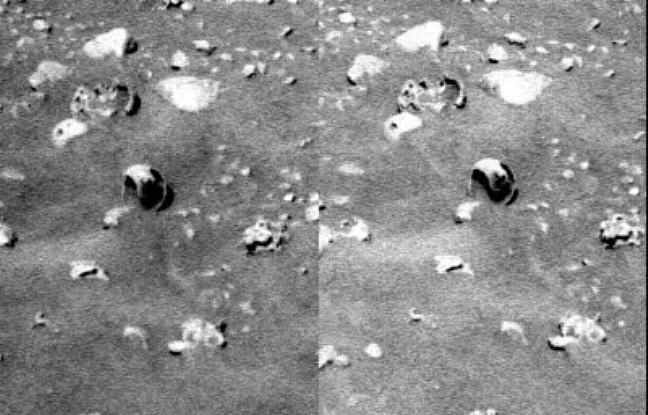
Vincent
Argument expected.
I don't require agreement when presenting new ideas.
-Dana Johnson
Offline
Like button can go here
#2 2008-04-15 17:47:51
- Vincent
- Banned
- From: North Carolina USA
- Registered: 2008-04-13
- Posts: 623
Re: Past and Present life on Mars
We all hear about the Mars berries. Strange, I didn’t think concretions would have baby berries inside. Looks like a cracked pod.
Vincent

Argument expected.
I don't require agreement when presenting new ideas.
-Dana Johnson
Offline
Like button can go here
#3 2008-04-27 06:31:54
- Vincent
- Banned
- From: North Carolina USA
- Registered: 2008-04-13
- Posts: 623
Re: Past and Present life on Mars
Part 1
In the Phoenix thread we got on the topic of life and the ability to detect and cIclops stated that it would need to be glaring to say for sure and I agree. I believe the Mars rovers have found life that required several images and trying to understand an alien worlds biological process.
I will incorporate some hypothesis of mine and others. Why we spend so much time scratching our head and looking at Mars images I have no idea.
The image on my previous post was a Berry on the exterior of a rock matrix that was hit by the robotic arm and shows the interior of the Berry and a complex inner structure. I believe in the end we will find we were looking at many types of Berries in various stage of life and even fossilized remains of Berries in the rock matrix and on the surface from a long time ago
The next image is a brushed rock with a cross-section showing the complex make-up of the Berry system.
Area I- is the cross section. With a hollowed out interior with small Berry development inside
Area II- is the stem system and its incorporation into the interior
Area III- is another broken top or side exposing smaller spherical in another stage of development.
Image 1 http://marsrovers.jpl.nasa.gov/gallery/ … 56M2M1.JPG

The next image shows complex repetitive anatomy including stems or rooting for some type of physiological process. The image was produced by Dana Johnson. Several of the images I will post are ones that I saved on my hard drive to ponder over the years and did not keep real good records. I never thought I would be trying to put a puzzle together on alien biology. I am more of a cloud man.
Here I will post two images of the same area. One will be the raw image from Dana Johnson and the next my analysis. In dealing with the smaller microscopic imager jpegs a little magnification will be necessary but not too much or pixilation will get you lost in the jpeg haze
Area I- shows four berries in the cluster with an apparent hole or stem exit point. I will post a separate jpeg of a lose Berry on the surface to close out part 1 that will give you a closer look at this feature.
Area II- shows four berries in a cluster with roots or stem systems leaving the Berries and going into the surface material or rock matrix.
Area III- shows a development of another material originating on the stem or root system that has started on two of the Berries and will continue to develop that I will get into in Part 2.
Vincent
Image 2a
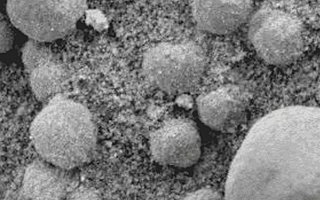
Image 2b
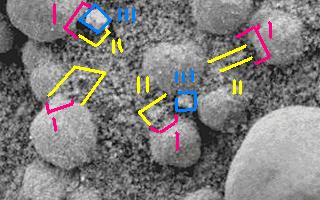
Image 3
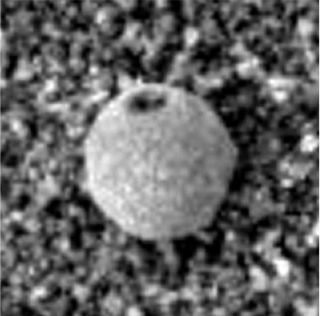
Argument expected.
I don't require agreement when presenting new ideas.
-Dana Johnson
Offline
Like button can go here
#4 2008-04-27 16:45:49
- Vincent
- Banned
- From: North Carolina USA
- Registered: 2008-04-13
- Posts: 623
Re: Past and Present life on Mars
Part 2
Now trying to piece alien biology together by visible data alone is difficult. Understanding biology on our own planet is difficult with all that is known. The universe shows repetition in most process on a galactic level so similarities in biology would make since.
Part one showed repetition in a relatively small area which would seem unlikely without biological influence.
Area III in the image above seems to generate at the stem or root system and cover the entire Berry and root/stem system and form a new matrix. Out of this it would appear a new type Berry growth and or secondary life form.
In the next image Stereo 3D
Area I- is the Berry system encapsulated in the new material.
Area II- New growth These features seem to be more cigar shaped with no evidence of
these features lose on the surface. I suspect they break down and are reincorporated into the surface material.
Image 2-1
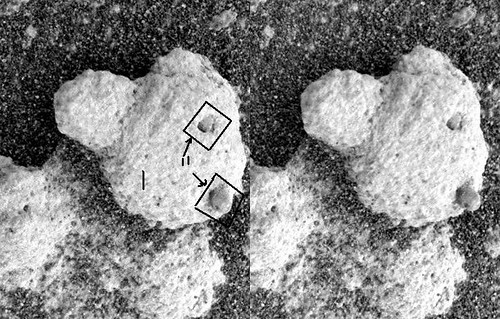
The effect of micro-climate and seasonal frost and moisture on Mars is unknown. On occasion what I believe are mini-biospheres have been seen. This next image is from Endurance Crater and shows an area of Berry development and associated bio development.
Image 2-2
Vincent
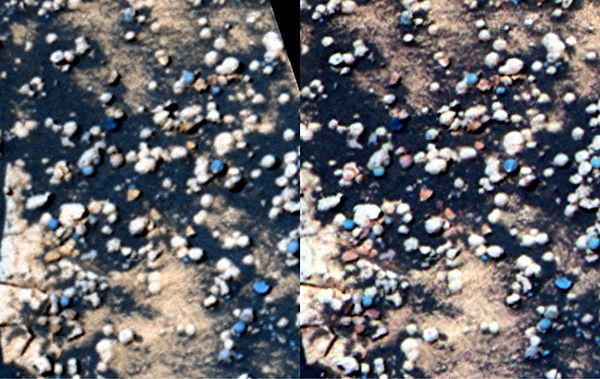
Argument expected.
I don't require agreement when presenting new ideas.
-Dana Johnson
Offline
Like button can go here
#5 2008-04-28 05:58:55
- Vincent
- Banned
- From: North Carolina USA
- Registered: 2008-04-13
- Posts: 623
Re: Past and Present life on Mars
Part 3
Just as a forest on Earth has many trees with many different sizes and shapes within a baseline of development and process Mars seems to be not that different.
Trying to understand the basic jump from geology to biology in a pure environment will take years and a man on the surface I believe. That being said not looking at the visible data with applied known process is not acceptable.
The image above shows Berries and many other objects within the area that show a very complex process. It is different from any other area in the vicinity. There most be a reason.
As I stated earlier we are looking at many different types of Berries that have a different purpose in the bio-cycle. The Mama Berry to use an Earthly analogy is just one. The cigar shaped growth after encapsulation is another. Next I will discus the Papa Berry for lack of a better term
These Berries seem to have a wider stem/root complex and like to stand high. If this is to get some chemical or other agent into the Martian atmosphere this would be a good idea.
Wind transport would be the only means of pollination and or expansion of colony. I have seen no birds or bees on Mars. I bet you are glad to hear that.
Below is an image in stereo 3D of this type. I have drawn arrows in case you can not find them
Vincent
Image 1-3
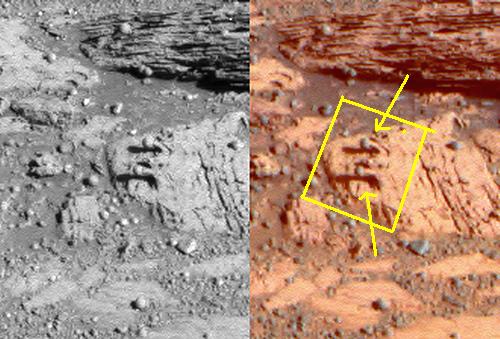
Argument expected.
I don't require agreement when presenting new ideas.
-Dana Johnson
Offline
Like button can go here
#6 2008-04-28 08:37:55
- Vincent
- Banned
- From: North Carolina USA
- Registered: 2008-04-13
- Posts: 623
Re: Past and Present life on Mars
Part 3a
As I have stated before I have been blessed to know some of the great image men on the net. I introduced you to, Dana Johnson, whose ability is to look at images in the context of process and who has a great ability to bridge the gap between geology, photon emission and biological process on any scale. He questions himself a lot in dialog but the man is a genius.
There is another one by the name of Hortonheardawho or Hort for those close, no we are not close. Hort and I disagree on most things. He can not see a lot of things I see, but the man can clear up the jpeg haze better than anyone. His color rendition is different than anyone because he understands things are different for a reason. Does that mean there is a reason for me? I will include a link to his site. If you like Mars you need to see it from Hort’s eyes.
The image below is a super resolution micro-imager image produced by Hortonheardawho. In it we get a rare glimpse at a Mama Berry and Papa Berry side by side. The first image is raw and the second is my analysis.
Hort link
http://www.flickr.com/photos/hortonheardawho/
3a-1
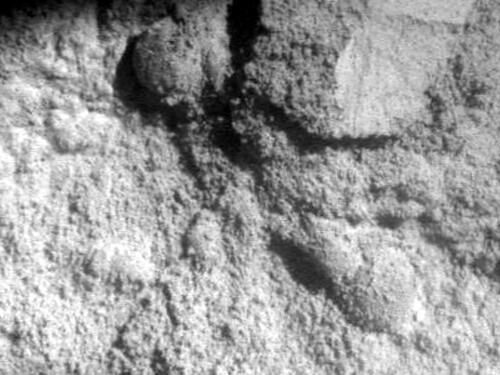
3a-2 analysis
Area IV- This is Mama Berry, notice she is smaller.
Area V- This is Papa Berry, notice it is wider and appears to have more mass.
Area I- this is the root/stem complex exit point on both
Area II- This is Mama Berry’s stem/root complex and it is smaller and thinner and is the genesis point of capsulation.
Area III- This is the Papa Berry stem/root system it is wide and stronger and has a remote control in its hand, just kidding.
Image 3a-2
Vincent
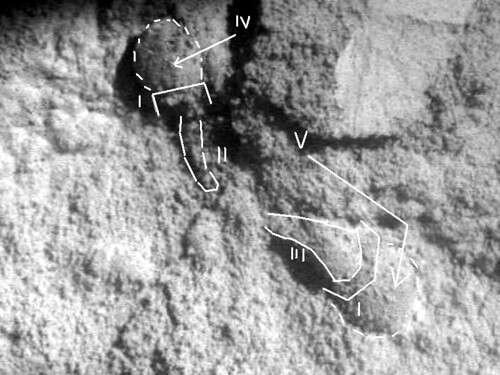
Argument expected.
I don't require agreement when presenting new ideas.
-Dana Johnson
Offline
Like button can go here
#7 2008-04-28 11:31:56
- zhar2
- Member
- From: london-uk
- Registered: 2008-03-17
- Posts: 106
Re: Past and Present life on Mars
Are you proposing they are some sort of fossils? :?
They look like pebbles to me.
Offline
Like button can go here
#8 2008-04-30 03:17:25
- Vincent
- Banned
- From: North Carolina USA
- Registered: 2008-04-13
- Posts: 623
Re: Past and Present life on Mars
Zhar2
Image 3a-1 are fossilized remains in my opinion. I believe there are Berries in an active state in some of the other images.
Vincent
Argument expected.
I don't require agreement when presenting new ideas.
-Dana Johnson
Offline
Like button can go here
#9 2008-05-05 08:09:19
- Vincent
- Banned
- From: North Carolina USA
- Registered: 2008-04-13
- Posts: 623
Re: Past and Present life on Mars
Part 4
In this section we will look at organization and repetition of process.
In respect to what are fossils and what are active Berries is a complex proposition in this alien environment. My description of Mama and Papa Berries is an Earthly description and denotes a complex biological process. In reality these objects may be asexual and there development more opportunistic.
The First image shows a Stemmed Berry that very well could be an erosion produced image. When interpreting visible data the image most be taken into context with or Earth eyes and ideologies taken into account to temper our bias.
Image 4-1

The second Image shows a Berry rising out of the surface material on a stem in an attempt to rise above and be in a position for air transport. This is what I mean by context.
Now you will hear me use the term surface material. I used the term soil and was informed by a few Geological scientist that that would indicate organic matter in the regolith. A spanking I will always remember. You guys think I am bad about captions that denote phase change, cloud heights or any atmospheric process, trust me, you do not want to be taken to the wood shed by some Geological types.
Vincent
Image 4-2
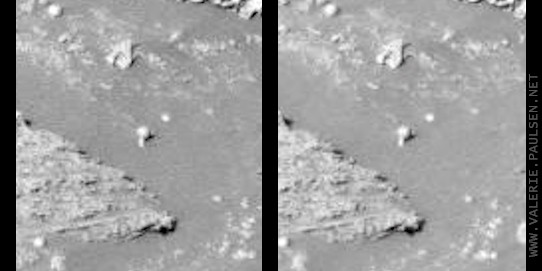
Argument expected.
I don't require agreement when presenting new ideas.
-Dana Johnson
Offline
Like button can go here
#10 2008-05-16 09:10:48
- Vincent
- Banned
- From: North Carolina USA
- Registered: 2008-04-13
- Posts: 623
Re: Past and Present life on Mars
Now as I ponder the possibilities of life on Mars I am presented by some Earth anomalies.
There are places in Central America near the death road, goggle it, that is above 15000 feet nothing grows. This got me to thinking, God forbid. This data was presented by Nat Geo. One of my favorite TV stations.
Now at 15000 feet on Earth the atmosphere is still 75 times stronger than Mars. The diurnal relative humidity is 1000 times grater. As we say down south, “What is the deal Lucile.”
Relativity? Now I know Einstein came up with that years ago but I think it applies. A mighty Oak tree would never survive in Death Valley California. Maybe life takes advantage based on relative environmental factors and evolution of such, what a concept.
Still groaning.
Vincent
Argument expected.
I don't require agreement when presenting new ideas.
-Dana Johnson
Offline
Like button can go here
#11 2008-05-24 15:43:07
- Vincent
- Banned
- From: North Carolina USA
- Registered: 2008-04-13
- Posts: 623
Re: Past and Present life on Mars
Rant 1247-14c
cIclops, I will try and number my rants. That number is to date
Now in the Phoenix Lander thread I mentioned the statement from Dr Bass that past life possibilities was the goal and life is a discovery for another mission.
Now if that is not a prejudice of science I will deliver news papers for the rest of my life.
We all know and respect the burden of the scientific standard, but we are dealing with robotic probes. I used the example of a corn field because of all the visible data I posted on this thread that was ignored by NASA. I see things that do not match the company line. I even got hydrogen data I have not posted yet at the Opportunity site because I was sort of hoping for some scientific types to chime in.
To quote myself, “Not a chance brother.”
Humans have eyes for reasons and they are designed to see certain things namely water and food.
I am excited about phoenix. Not for any revelation from NASA but the great minds that think for themselves. They will post their findings on their sites and forums. Not saying they are right but they are the best of the lot and are not puppets or easy interviews.
I have named them from time to time. If you want a complete list just ask.
Viencent
Argument expected.
I don't require agreement when presenting new ideas.
-Dana Johnson
Offline
Like button can go here
#12 2012-05-05 19:57:37
- SpaceNut
- Administrator
- From: New Hampshire
- Registered: 2004-07-22
- Posts: 29,924
Re: Past and Present life on Mars
THIS SITE reports the discovery inside a Martian meteorite of egg-shaped globules rich in carbon and oxygen.

Professor Chandra Wickramasinghe said the globule from the rock named Tissint is rich in carbon and oxygen and insisted they could only have been produced by living organisms.
... The meteorite was named after the village where it came down in the Sahara desert in Morocco last July.
It was probably blasted from Mars when it was hit by an asteroid millions of years ago.... PhD student Jamie Wallis, who was working with Dr Wickramasinghe, said: "All the indications are that structures such as we have found are evidence of life on Mars.
“The spheres are probably remnants of polysaccharide shells surrounding algal type cells."... Earlier this month, another group of scientists claimed that the first two Viking probes that NASA landed on Mars in 1976 discovered life but failed to recognise it.
Offline
Like button can go here
#13 2012-05-20 19:11:42
- SpaceNut
- Administrator
- From: New Hampshire
- Registered: 2004-07-22
- Posts: 29,924
Re: Past and Present life on Mars
Most likely long in early times of Mars life would have been much like this with regards to how it moved:...Microbes at the Edge of Space via the dust storms that we see now....
Offline
Like button can go here
#14 2012-05-26 05:17:17
- JonClarke
- Member
- From: Canberra, Australia
- Registered: 2005-07-08
- Posts: 173
Re: Past and Present life on Mars
THIS SITE reports the discovery inside a Martian meteorite of egg-shaped globules rich in carbon and oxygen.
http://img.thesun.co.uk/multimedia/arch … 98197a.jpg
Professor Chandra Wickramasinghe said the globule from the rock named Tissint is rich in carbon and oxygen and insisted they could only have been produced by living organisms.
... The meteorite was named after the village where it came down in the Sahara desert in Morocco last July.
It was probably blasted from Mars when it was hit by an asteroid millions of years ago.... PhD student Jamie Wallis, who was working with Dr Wickramasinghe, said: "All the indications are that structures such as we have found are evidence of life on Mars.
“The spheres are probably remnants of polysaccharide shells surrounding algal type cells."... Earlier this month, another group of scientists claimed that the first two Viking probes that NASA landed on Mars in 1976 discovered life but failed to recognise it.
You do realise that the Sun is not a credible source?
Offline
Like button can go here
#15 2012-11-05 17:11:16
Offline
Like button can go here
#16 2012-11-06 16:10:33
- GW Johnson
- Member
- From: McGregor, Texas USA
- Registered: 2011-12-04
- Posts: 6,108
- Website
Re: Past and Present life on Mars
I'd be surprised if we found extant microbial life on the surface, due to the harsh UV radiation and the extreme-dessication of the atmosphere and top few cm of surface.
Because I think it likely there was once lots of microbial life when the climate was more benign, I would be very unsurprised to hear we found extant microbial life underground.
I'd be surprised to hear (someday) we found fossils of multicellular life on Mars, because the climate there "went bad" so very long ago. Things were equable (as we understand it) for only a billion or two years. Here, it took nearly 4 billion to reach multicellular forms. (Only data point we have.)
GW
GW Johnson
McGregor, Texas
"There is nothing as expensive as a dead crew, especially one dead from a bad management decision"
Offline
Like button can go here
#17 2012-12-27 04:05:48
- Void
- Member
- Registered: 2011-12-29
- Posts: 9,086
Re: Past and Present life on Mars
I have always been very negitive on the notion of surface life on Mars, but have in the last 6 months had to open to the idea that near surface life is possible.
I consider the following to be "Near Surface":
-Cracks in rocks, exposed to the air and sunshine.
-Salt in salt pans.
-Ice exposed to sunlight by the impact of a Earth Rock.
CRACKS IN ROCKS:
Evidence suggesting the Lichen and Cyanobacteria can survive and motabolize for at least 1 Month under present Martian conditions:
http://www.planetary.org/blogs/guest-bl … -mars.html
I have read several of these articles, that indicated that Lichen motabolizes and is happy in a (Stated as full) simulation of current Martian conditions. I have also been studying Lichen and learned that it can draw mositure and saturate in 30? seconds. Apparently according to these articles, there is a very short duration between the day and night environments, perhaps twice a day at some locations where a tiny amount of dew can exist, long enough to water the lichens and I presume the Cyanobacteria. It seems that cracks in the rock or even soil can favor survival. I was skeptical that it can deal with the UV light, but they seem to indicate that it can. I have trouble with that still, because I was previously instructed by all writtings from the authorities previous, that the UV is totally lethal to all life. But these articles say the simulation included the radiation environment. (I hope by that they do indicate the UV was a full simulation).
If you have reason to think that I have been given a false understanding please let me know.
Anyway as I said, I have been reading up on lichen, and also have learned that in some cases it does not even need liquid water, but can absorb moisture directly from frost or in some cases directly from a high humidity. I do know that the Martian atmosphere saturates with humidity at night quite often.
Another feature is that lichen exhibits motabolism at rather low temperatures. It does better at above freezing temperatures.
http://www.researchgate.net/publication … s_below_0C
Quote:
Abstract
Laboratory measurements show that lichens are extremely tolerant of freezing stress and of low-temperature exposure. Metabolic activity recovered quickly after severe and extended cold treatment. Experimental results demonstrate also that CO2 exchange is already active at around −20°C. The psychrophilic character of polar lichen species is demonstrated by optimum temperatures for net photosynthesis between 0 and 15°C. In situ measurements show that lichens begin photosynthesizing below 0°C if the dry thalli receive fresh snow. The lowest temperature measured in active lichens was −17°C at a continental Antarctic site. The fine structure and the hydration state of photobiont and mycobiont cells were studied by low-temperature scanning electron microscopy (LTSEM) of frozen hydrated specimens. Water potentials of the frozen system are in the range of or even higher than those allowing dry lichens to start photosynthesis by water vapor uptake at +10°C. The great success of lichens in polar and high alpine regions gives evidence of their physiological adaptation to low temperatures. In general lichens are able to persist through glacial periods, but extended snow cover and glaciation are limiting factors.
SALT PANS:
I think that this article is very interesting:
http://digital.csic.es/bitstream/10261/ … 264561.pdf
For me, much of it is written in a Martian dialect, but I gather from it, that they assert that in certain circumstances salt can have sufficient moisture and high enough temperatures for Eart life to live in it. Certainly I think that the maps are interesting.
In this case because of the previous information about lichen and cyanobacteria being able to deal with UV, I would suppose UV will not prohibit life. But if it turned out that it does, I would suppose that deeper down in the salt pan the UV would be moderated or absent.
ICE EXPOSED TO SUNLIGHT BY AN EARTH IMPACTOR:
I have no reference for this on, but I recall that some notion exists that an impactor from Earth could punch through a soil layer into ice, exposing the ice to sunlight, and that liquid water could exist from solar energy for a period of time. (The liquid water would be contained by the physical strength of the surrounding ice. So, this would be a very great pathway for the innoculation of Mars by Earth organisms, over the duration of planetary existance.
So I guess I will finish by saying that it seems plausable to me that Earth life could be currently living on Mars, but I also have to note that we have not been shown any evidence of it. I presume that is because it has not been observed/detected.
I actually just want to hear any arguments you might have against my "Logic" : >
Do I have my head on strait on this one?
Last edited by Void (2012-12-27 04:25:57)
Is it possible that the root of political science claims is to produce white collar jobs for people who paid for an education and do not want a real job?
Offline
Like button can go here
#18 2012-12-27 12:58:41
- bobunf
- Member
- From: Phoenix, AZ
- Registered: 2005-11-21
- Posts: 223
Re: Past and Present life on Mars
John Maynard Keynes: "That all things are possible is no excuse for talking foolishly."
Void, all you've done is list a bunch of suppositions with no evidence that any of it actually occurred.
What there is evidence for:
> After meticulously inspecting virtually every square meter of the surface of Mars for decades from orbit and from multiple rovers and landers, there is nothing to suggest the effects of any kind of life. Even a few parts of the sub-surface have been poked at, yielding nothing.
> After decades of increasingly sophisticated analysis, the Martian atmosphere shows no effects of life whatever.
> After decades of examining meteorites from Mars, there is no confirmed evidence of any effects of life.
The negative will never be proved, but one can make an educated assessment. Namely, there probably isn't any life on Mars, and if there is any, it has to be in extremely tiny amounts. The upper limit of that quantity of life declines with each new measurement from Mars, measurements which come in hourly.
Most likely, when we get around to colonizing Mars, we won't have to worry about any indigenous life.
Last edited by bobunf (2012-12-27 13:00:08)
Offline
Like button can go here
#19 2012-12-27 14:56:28
- Void
- Member
- Registered: 2011-12-29
- Posts: 9,086
Re: Past and Present life on Mars
Well thanks for giving a reply.
supposition:
http://www.thefreedictionary.com/supposition
Noun 1. supposition - a message expressing an opinion based on incomplete evidence
guess, speculation, surmisal, surmise, conjecture, hypothesis
opinion, view - a message expressing a belief about something; the expression of a belief that is held with confidence but not substantiated by positive knowledge or proof; "his opinions appeared frequently on the editorial page"
Yes, I did. Aside from having all the complete set of information, trying to define what is the additional information you should be looking for can be supported with the use of "guess, speculation, surmisal, surmise, conjecture, hypothesis". It might even be used in science, I am suppositioning. ![]()
Seriously, I am grateful that you have tried to improve my thinking process.
Quotes:
John Maynard Keynes: "That all things are possible is no excuse for talking foolishly."
Foolishness, the quality of having poor judgement or little intelligence
I would prefer being refered to as ignorant, but yes at times I use poor judgement.
"A man who calls his brother a fool is in danger of going to hell". Don't throw it about so freely. Call me ignorant please. I am ignorant. Thats what happens before you go to school.
I will try to rephrase what I was getting at:
Mars appears to have had the capacity to support life at times, and may still have it in certain locations such as aquifers, and perhaps in the near surface of cracks in rocks, and salt pans. Mars also has climatic periods even now (Last 200 Million years) where a stronger axial tilt could allow a ambient pressure of 11 mb, and snowfall/water ice from other condensation in the equatorial regions. Mix salt with ice with a somewhat below freezing temperature (Fresh Water Freezing), and you can likely get a salt water seep, puddle, or even a lake. If the environment were occasionally like that of the dry valleys of Antarctica (A big stretch), then solar heated salt water covered with less salty water, covered with transparent/translucent ice.
So, if panspermia/transpermia can work, it might have.
I agree that no conculsive evidence for life exists and certaintly not lichen. (Not completely ruling it out though).
The German experiment suggests that if lichen were transplanted to certain microenvironments on Mars it could persist for at least 30 days. The same for Cyanobacteria.
I like you would prefer that there were no life on Mars, especially now that I understand how close Mars is in capability to adopt certain Earth life forms.
I am deeply curious as to why it would not have life.
I have to supposition that there are reasons, and I would like to find them out or find life.
Last edited by Void (2012-12-27 15:15:04)
Is it possible that the root of political science claims is to produce white collar jobs for people who paid for an education and do not want a real job?
Offline
Like button can go here
#20 2012-12-27 17:41:01
- bobunf
- Member
- From: Phoenix, AZ
- Registered: 2005-11-21
- Posts: 223
Re: Past and Present life on Mars
Is is easy to understand how there could be no life on or in Mars: abiogenesis is rare and interplanetary transport of life is difficult. Besides conditions on Mars are difficult in many ways.
The hypotheses that abiogenesis is rare and interplanetary transport of life is difficult are also supported by the facts that there is no hint of a second abiogenesis on Earth, nor of life anywhere else in our our solar system, nor in the rest of the universe.
The origin of life is not understood, but it is not hard to imagine that it is a very rare event. The effects of an impact that removed samples of life from Earth, the radiation, vacuum and cold of space, the issues of entry through an atmosphere and impact on a planet's surface all make it rather easy to imagine that interplanetary transport of life is difficult.
The simplest and quite plausible explanation for all of our observations to date is that there is, indeed, no life on Mars, anywhere else in our solar system except Earth, and not anywhere else in the universe.
Last edited by bobunf (2013-01-02 01:55:21)
Offline
Like button can go here
#21 2012-12-28 05:39:03
- Void
- Member
- Registered: 2011-12-29
- Posts: 9,086
Re: Past and Present life on Mars
I can accept that you have that conclusion, and would require a contrary fact in order to consider changing it.
None is provided to the public, and most likely no such evidence is in the possession of any person called human.
I am curious. What is your interest in Mars?
The search for life is one of the things that has seemed to interest the scientific community.
I can name 3 of possible reactions to the existance of Mars as a potential habitible world.
Creationist:
a) 1 God driven origin of life on Earth, very little interest in Mars.
b) 1 God driven origin of life on Earth, but not ruling out other creations, could more easily adapt to findings of life elsewhere.
Atheist:
- Would likely prefer life to be found, in hopes of disputing other relegious doctrins.
In both of the above cases, it is my personal thinking that rights to power over the human race are involved, so they concern manipulating people, who in turn manipulate objects as a secondary object.
Materialist:
- Most likely not linking the existance of life outside of the Earth with the purpose of expansion into space.
In this case obviously, the agenda is to manipulate objects, which in turn does also manipulate people.
You don't have to answer at all of course, I am curious are you primarily an object manipulator, or a people manipulator?
Something else?
Is it possible that the root of political science claims is to produce white collar jobs for people who paid for an education and do not want a real job?
Offline
Like button can go here
#22 2013-01-03 10:34:08
- bobunf
- Member
- From: Phoenix, AZ
- Registered: 2005-11-21
- Posts: 223
Re: Past and Present life on Mars
My personal interest in Mars is that visiting the planet, establishing bases (similar to the situation in Antarctica), and colonizing Mars would be one hell of an adventure. From a broader perspective, it would also be good to have humans located in more than one place so that a single disaster would not necessarily cause the extinction of the species.
The scientific return of a serious presence on Mars would be enormous. On Mars we can study comparative geology, comparative meteorology and comparative climatology in a setting that is different from Earth, but not as different as any other place in our solar system.
It is really, really helpful to study phenomena under different conditions. Just for instance, think of what can be learned about water under different conditions of temperature. Water becomes ice; water becomes vapor. Vary the pressure or salinity and water has different melting and boiling points. From these observations we find ice for food preservation, tastier drinks, making ice cream, and sculpture; steam for power and heat; salts for clearing ice from roads and walkways; engine coolants; and these are just the very beginning.
Mars is another data point. With geology, for instance, unlike Earth, Mars has preserved a much more ancient landscape. Understanding this ancient landscape, and how Mars become so different from Earth, will help with understanding Earth’s own geological history. How does erosion work with lower temperatures, more extreme temperature variation, less air pressure, lower gravity, and a thoroughly different atmosphere? What happens and has happened geologically as the core cools?
With climatology, what kind of climate cycles exist on Mars; how are they generated; and how do those cycles and mechanisms compare to Earth? It appears that Mars is in a comparative Ice Age. Could that give us clues as to how Ice Ages are triggered on Earth? With meteorology, how do weather systems develop with no oceans, a dimmer sun, and lower gravity?
Did Mars ever have reversals of its magnetic poles? How does the solar wind interact with a weakly magnetized planet? There would be interesting opportunities for astronomical observations. All of Mars is almost like being in space as far as atmospheric effects are concerned; and the different location of Mars, its increased distance from Sun, and the lack of radio noise would be helpful.
The list of questions is endless; and some of the answers could be really valuable. Then there is the issue of life, which could have important consequences for our understanding of life, its origins, processes and possibilities. A study of comparative biology would lead to incredible insights and very practical results.
However, if life is found on Mars, it means that interplanetary (and possibly interstellar) transport of life is practical, or that abiogenesis is not rare. This would mean that the reasons for the Great Silence would not include that interstellar transport of life is impractical and that abiogenesis is rare. Other reasons, of necessity, would be more likely; and those reasons include a short lifetime for technological civilizations such as ours.
Finding life on Mars would suggest a bad prognosis for the long term survival of our civilization and us. Also, if life is found on Mars, it will make visiting, bases and colonization more problematic and, in any case, much more complex, what with issues of contamination, back contamination and preservation.
Offline
Like button can go here
#23 2013-01-03 10:36:46
- bobunf
- Member
- From: Phoenix, AZ
- Registered: 2005-11-21
- Posts: 223
Re: Past and Present life on Mars
All in all, the discovery of life on Mars will be very exciting, but the aftermath depressing.
I doubt such a discovery would have much effect on religion. Really, why should it?
As far as Mars is concerned, I am not a people or object manipulator; but an observer.
Offline
Like button can go here
#24 2013-01-05 20:50:58
- louis
- Member
- From: UK
- Registered: 2008-03-24
- Posts: 7,208
Re: Past and Present life on Mars
UK paper says it's a flower....possibly...
Let's Go to Mars...Google on: Fast Track to Mars blogspot.com
Offline
Like button can go here
#25 2013-01-06 10:43:05
- GW Johnson
- Member
- From: McGregor, Texas USA
- Registered: 2011-12-04
- Posts: 6,108
- Website
Re: Past and Present life on Mars
Very interesting. Very odd-looking. From what I have seen and read, it appears to those investigating it that it is stuck into the rocks, which rules out the "plastic trash from the rover" hypothesis. It will be very interesting to see how this plays out. I've seen lots of clear crystal minerals, but never something curved.
GW
GW Johnson
McGregor, Texas
"There is nothing as expensive as a dead crew, especially one dead from a bad management decision"
Offline
Like button can go here
